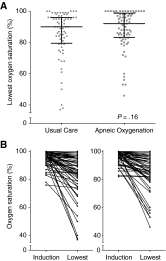Randomized Trial of Apneic Oxygenation during Endotracheal Intubation of the Critically Ill
- PMID: 26426458
- PMCID: PMC4803060
- DOI: 10.1164/rccm.201507-1294OC
Randomized Trial of Apneic Oxygenation during Endotracheal Intubation of the Critically Ill
Abstract
Rationale: Hypoxemia is common during endotracheal intubation of critically ill patients and may predispose to cardiac arrest and death. Administration of supplemental oxygen during laryngoscopy (apneic oxygenation) may prevent hypoxemia.
Objectives: To determine if apneic oxygenation increases the lowest arterial oxygen saturation experienced by patients undergoing endotracheal intubation in the intensive care unit.
Methods: This was a randomized, open-label, pragmatic trial in which 150 adults undergoing endotracheal intubation in a medical intensive care unit were randomized to receive 15 L/min of 100% oxygen via high-flow nasal cannula during laryngoscopy (apneic oxygenation) or no supplemental oxygen during laryngoscopy (usual care). The primary outcome was lowest arterial oxygen saturation between induction and 2 minutes after completion of endotracheal intubation.
Measurements and main results: Median lowest arterial oxygen saturation was 92% with apneic oxygenation versus 90% with usual care (95% confidence interval for the difference, -1.6 to 7.4%; P = 0.16). There was no difference between apneic oxygenation and usual care in incidence of oxygen saturation less than 90% (44.7 vs. 47.2%; P = 0.87), oxygen saturation less than 80% (15.8 vs. 25.0%; P = 0.22), or decrease in oxygen saturation greater than 3% (53.9 vs. 55.6%; P = 0.87). Duration of mechanical ventilation, intensive care unit length of stay, and in-hospital mortality were similar between study groups.
Conclusions: Apneic oxygenation does not seem to increase lowest arterial oxygen saturation during endotracheal intubation of critically ill patients compared with usual care. These findings do not support routine use of apneic oxygenation during endotracheal intubation of critically ill adults. Clinical trial registered with www.clinicaltrials.gov (NCT 02051816).
Trial registration: ClinicalTrials.gov NCT02051816.
Keywords: airway management; intratracheal intubation; pulmonary ventilation.
Figures



Comment in
-
Apneic Oxygenation for Intubation in the Critically Ill. Let's Not Give Up!Am J Respir Crit Care Med. 2016 Feb 1;193(3):230-2. doi: 10.1164/rccm.201510-1998ED. Am J Respir Crit Care Med. 2016. PMID: 26829418 No abstract available.
-
Apneic Oxygenation Has Not Been Disproven.Am J Respir Crit Care Med. 2016 Jun 1;193(11):1316. doi: 10.1164/rccm.201603-0510LE. Am J Respir Crit Care Med. 2016. PMID: 27248594 No abstract available.
-
Reply: Apneic Oxygenation Has Not Been Disproven.Am J Respir Crit Care Med. 2016 Jun 1;193(11):1316-7. doi: 10.1164/rccm.201603-0604LE. Am J Respir Crit Care Med. 2016. PMID: 27248595 Free PMC article. No abstract available.
References
-
- Jaber S, Amraoui J, Lefrant J-Y, Arich C, Cohendy R, Landreau L, Calvet Y, Capdevila X, Mahamat A, Eledjam J-J. Clinical practice and risk factors for immediate complications of endotracheal intubation in the intensive care unit: a prospective, multiple-center study. Crit Care Med. 2006;34:2355–2361. - PubMed
-
- Griesdale DEG, Bosma TL, Kurth T, Isac G, Chittock DR. Complications of endotracheal intubation in the critically ill. Intensive Care Med. 2008;34:1835–1842. - PubMed
-
- Simpson GD, Ross MJ, McKeown DW, Ray DC. Tracheal intubation in the critically ill: a multi-centre national study of practice and complications. Br J Anaesth. 2012;108:792–799. - PubMed
-
- De Jong A, Molinari N, Terzi N, Mongardon N, Arnal J-M, Guitton C, Allaouchiche B, Paugam-Burtz C, Constantin J-M, Lefrant J-Y, et al. AzuRéa Network for the Frida-Réa Study Group. Early identification of patients at risk for difficult intubation in the intensive care unit: development and validation of the MACOCHA score in a multicenter cohort study. Am J Respir Crit Care Med. 2013;187:832–839. - PubMed
-
- Mort TC. The incidence and risk factors for cardiac arrest during emergency tracheal intubation: a justification for incorporating the ASA guidelines in the remote location. J Clin Anesth. 2004;16:508–516. - PubMed
Publication types
MeSH terms
Substances
Associated data
Grants and funding
LinkOut - more resources
Full Text Sources
Other Literature Sources
Medical

